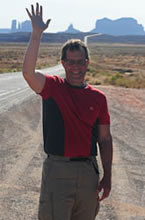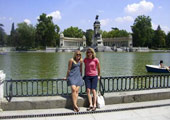So my picture-perfect sidewalk café, Fanta Limon reunion didn’t go exactly as I’d imagined. Instead we got delayed flights, mis-communications and near-misses, with me dazed and sleep-deprived, dragging a wheeled suitcase through the airport. When I finally spotted her, I grabbed my Annie tight and we laughed for a while. That mixture of joy and confusion set the tone for our entire two weeks of travel in Spain.

Annie and Jean at the Alcazar in Segovia
We were both more than ready to be back together. Me, especially after getting Annie’s frantic call from a seedy bus station in Malaga where she’d had her purse stolen. (Fortunately, she’d actually listened to my money-belt lecture that very morning and lost only her camera and cell phone.) Or getting her call from the Eiffel Tower on 7/7/07 with Annie saying, “Gotta go—something just exploded” and hanging up. Jim turned on the news to make sure the Eiffel Tower hadn’t blown up. It hadn’t.
On Annie’s part, she was ready to let someone else worry about stuff like passports and credit cards, and to sleep in nicer hotel rooms than those of her discount weekend excursions with friends. (She’d slept with four girls in a double bed—sideways—in Paris to save money.) Mostly, she was ready to let Mom assume responsibility for asking for directions and for dealing with clerks and waiters. She’d rather search for her own solutions than ask strangers for help, she says.

Lovely Annie, swirling in Barcelona’s Plaza de Catalunya
El Idioma
For me, social interaction wasn’t an issue; I am the Brave Talker of the family, after all. My problem was more one of inadequate Spanish; I have the approximate skills of a three-year-old Spaniard. I’d reviewed my old textbooks, but the fact remained that I hadn’t taken any formal foreign language classes since 1981. Annie’s Spanish was much better than mine, particularly after just completing a six-week immersion program in Segovia. This created some tension for us, or as Annie put it, “If we were the same person, we’d do really well.” In the end, our family norm prevailed and I became a Brave Talker in Spanish. In fact, I spewed my Bad Spanish upon Spaniards everywhere.
Normally this worked pretty well if the answers I got were short and to the point. From the bus driver: “No, you want the bus on the other side of the street. Or from the museum security guard: “The bathrooms are at the back to the left.”

Annie running up the Barcelona Citadel
But sometimes I’d get a long rambling answer and understand only half the message and Annie would have rambled off herself, out of earshot. If it were something really important, like where was the Italian restaurant, I’d have to call her back and make them repeat their response.
In the plaza of San Lorenzo, I asked an older woman which restaurant she thought was best and she got into an argument with some of the plaza pensioners about it. I understood that one particular place was good--just orderthe Menu del dia. Or was it just don’t order the Menu del dia? Annie and I went with the Menu del dia.

Jean re-creating arrow shooting into cauldron at Barcelona’s Olympic Stadium
To up the challenge we visited Barcelona where they speak Catalan--a mixture of Spanish, French and Portuguese. My brain got really messed up here. Nearing the 1992 Olympic Park, I asked a senior Spanish lady for directions with “Excusez-moi?” The poor woman looked puzzled. Annie was just dying. I took two terms of French in college but nothing since and here I was speaking French; it was like speaking in tongues. If I’d stayed longer, surely I’d be speaking Portuguese by now.
Right after that, a Spanish man asked me for directions (big mistake) for the “Poble Espanol?” (a tacky Spanish tourist village with a Catalan name). Now “Poble Espanol” spoken fast sounds a lot like “habla Espanol?” or “Do you speak Spanish?” He thought it was pretty funny when I answered “a little” in Spanish. Making these errors were the only times most locals smiled at us. Americanas Estupidas, they’d chuckle. We’d just laugh back.


Jean escaping the Alcazar dungeon in Segovia Annie hating Spanish food in Sevilla La Comida
Other than our language issues, our greatest challenge was probably la comida, or the food. Spanish food is ham and more ham, with other meats, eggs and unidentifiable seafood thrown in. I carried a Spanish-English dictionary but found we used it only at restaurants to make sure we weren’t eating something scary. How about some “bulls-tail soup” or “meat-filled pastries” or “fried eggs of the bull”? (And not the kind of eggs you’d use in an omelet.) Annie and I, on the other hand, are unintentional vegetarians: we’ll eat meat but prefer almost anything else. Plus Annie had already been eating serious Spanish food for six weeks, prepared by her over-worked young host mother with a penchant for canned goods.

Annie getting a kiss from her host sister Noelia on our return to Segovia
Annie didn’t even want the renowned Spanish appetizers called tapas anymore. Or as she put it, “I like the idea of tapas, I just don’t like tapas themselves. I wish they had a Pan-Asian version of tapas, like stuff we get in Seattle.” I grew more sympathetic with her food issues after trying to order watermelon sorbet and getting watermelon, period. But it was very nice watermelon.

Annie trying to identify a piece of seafood in her paella--probably squid--in San Lorenzo
Fortunately we discovered a solution to our problems: Italian restaurants. Italy isn’t that far from Spain and their restaurants were pretty available, plus we realized we already spoke Italian food fluently (Ravioli! Tortellini!), so that’s what we did. And we were very happy.
La Moda
This brings us to fashion, or la moda. Spanish fashion has come a long ways in the past thirty years and Annie and I had to check it out. We normally wear size small at home but in Spain we were both larges. Looking around, we saw that Spanish women are tiny! Annie has a theory: They are so small because their food is so awful. She may be onto something. It made us feel better anyways. (We also noticed that our Italian tourist friends appeared much better fed.)

Annie shopping in Barcelona
Everywhere we looked, we saw middle-aged Spanish ladies with short punk hairstyles, dyed a goth-shade of deep red. And these women have no problem showing the backs of their bra straps. But I do have to say they sport very stylish eyewear.



El Piropo
Despite not being part of the latest local fashion trends, we got attention, Annie especially. Thirty years ago I remember these cat-calls, or piropos, and being sort of skeeved by them, as Annie is today. Now I kinda like them.
A waiter at (an Italian) restaurant in Sevilla asked if Annie and I were friends. Upon hearing the word madre (mother), he shook my hand and brought me a complimentary glass of white wine. I’d have preferred a Diet Peach Snapple, but took a few sips to celebrate the moment.
The ticket saleslady at the Sevilla Cathedral grew frustrated with me when I wouldn’t hand over my student identification along with Annie’s. (Getting yelled at in Spanish is an interesting experience.)
I’m not sure why this kept happening, but I loved it. Maybe our Norwegian-German heritage messed with their age perceptions, or maybe they aren’t used to many mother-daughter travelers? Maybe they were thrown by my lack of punk red hair? I can already hear Zach and Taylor asking if Spaniards have inadequate eye care. Whatever it is, I highly recommend traveling to Spain as an ego-boost for middle-aged American women.

Jean hugging the 2000 year old aqueduct in Segovia (I know, I know. This is all kinds of wrong.)
Post-Franco
I was glad to see the piropo still around after thirty years but a lot else has changed since those early post-Franco days of my last visit. Back then, Spaniards everywhere were just awakening from a long dreary nap of Fascist oppression. They were rubbing their eyes and looking around at a new world with new opportunities. Now they’re not only wide awake, it’s happy hour in Spain.
Here are some specific changes I noticed since 1977:
- The existence of real toilet paper, not that brown wrapping-paper-like stuff (ouch!), or the rolling crepe paper--if you were lucky.
- Cleavage. Nearly everywhere and everyone. Tops optional at the beach and the hotel pool. (Quite a difference from when they covered up naked oil paintings at the Prado Museum.)
- Finding the words “NO” and “FUMAR” (smoking) anywhere near each other. There’s still plenty of smoking, but you’ll find the occasional restriction now.
Mal Educado
Mal Educado sounds like poorly educated, but it really means bad manners. We already knew that smoking, sadly, will never be bad manners in Spain, but we had to learn some of the other rules of etiquette. Here’s a little test.
Which part of each sentence is mal educado?
- Drinking a beverage of any kind in public outside a restaurant ----or-- public displays of much affection anytime, anyplace
- Saying “thank you” and “I’m sorry” too much –or-- saying “thank you” and “I’m sorry” too little
- Stretching or stifling a yawn –or-- blowing your nose at breakfast
- Picnicking on public grass–or-- hissing and smacking at women
- Standing on the left side of the escalator –or-- pushing and shoving your way up the escalator
All the actions on the first part of each sentence are very, very bad and may earn you the wrath of an angry Spaniard. The actions of the second part of each sentence are perfectly fine, desirable even. We claimed ignorance with the beverage rule; it was just too hot to do without our Coca-Cola Lights or water bottles while out running around.

Jean ready to fight bulls in Sevilla, using her hat for a cape
El Bide’
You know what these are, and they are still a little scary, even in Spanish, aren’t they? But they are everywhere, so Annie did a little Internet research on the subject.
She learned that the bidetgot a bad wrap during World War II when American G.I.s saw French ladies of the evening using them, um, after, and made an association between the two. In reality, Europeans use the bidet for everything from washing their babies to washing their feet. Think little shower, not toilet. We found them handy for cleaning our feet after a long day of site-seeing. But I still don’t think I need one at home.

Jean washing her feet in her hotel room bidet in Barcelona
La Princesa de Barcelona
With clean feet and new Spanish sundresses, we headed for the Sardana dance at the Cathedral Plaza in Barcelona. The Sardanas weren’t out, but Annie spotted some other musicians and older couples dancing nearby. She was “creeped out” (her words, and she wants you to know it) when a senior gentleman whisked her out for a spin. My Annie was--for a few minutes at least--the princess of Barcelona. To close my story, watch this short video link of her dancing below. Note all the tourists holding their movie cameras above their heads to record the memory (and catch the only other dancer—an older lady with a cane.) Perhaps thirty years from now, Annie will bring her own daughter back to Spain. I’ll bet they’ll dance.
http://www.youtube.com/watch?v=NcNw_If8s-Q

